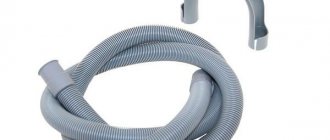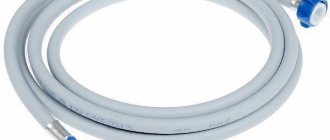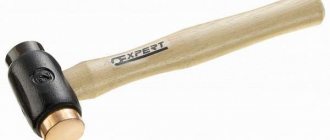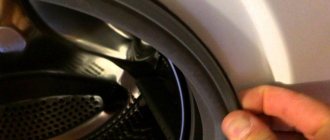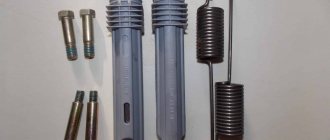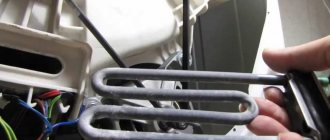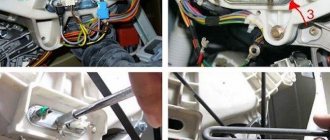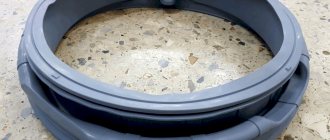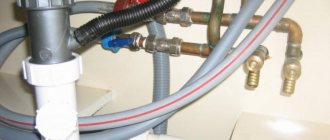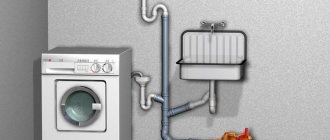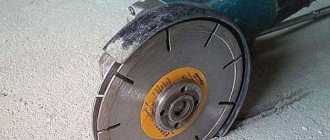When purchasing a washing machine, it is important to choose the right installation location. The ideal location implies unhindered access to sewerage, water and electricity. However, sometimes a situation arises when the unit cannot be installed near all communications. This leads to the need to lengthen the drain hose of the washing machine. How to do this correctly so as not to disrupt the operation of the equipment?
In order to solve the problem of a short drain hose in a washing machine, you need to lengthen it or install a new one of a suitable length
Through siphon
Installing the connection using this method is special in that we connect the washing machine’s drain hose not to a sewer pipe or its branch, but to another plumbing element - the sink siphon. In modern siphons, manufacturers provide a special outlet for connecting a washing machine, which we should use.
The essence of connecting the washing machine via a siphon is as follows. We install a siphon and check how the water is drained through the drain hole of the sink, make sure that there are no leaks. The siphon can be easily installed with your own hands without any tools. If you have problems with this, you can read the article Siphon for a washing machine - installation and connection. Next, connect the drain hose to the side outlet of the siphon, not forgetting to seal the joint. The hose must be bent into an “S” shape; if this is not done, the first wash will end with the machine hanging in the middle.
Directly into the sewer pipe
You can also connect the washing machine to a sewer pipe outlet located nearby. To do this, such a withdrawal needs to be organized. Let's do the following.
- We purchase a tee for a sewer pipe.
- Use a pipe cutter to cut a plastic sewer pipe.
- We install the tee and seal the joint.
Well, the pipe outlet is organized
In this case, it is very important that the outlet be located at a height of at least 40 cm from the floor level. Insert the end of the drain hose into the pipe outlet and seal the connection
We additionally strengthen the connections with a clamp so that the pressure does not accidentally cause the pipe to jump out and flood the entire floor. We bend the hose into an “S” shape and secure it so that it does not dangle.
In conclusion, we note that connecting an automatic washing machine to the sewer is really not difficult if you follow the simplest instructions, which have long been formulated by specialists. You can do it too. Read this article and get started, good luck!
To start
Remember two main rules that must be followed before any repair work on household appliances.
Shut off the water
Close the water supply shut-off valves. They are usually located behind the washing machine on pipes. Now, even if the hose is damaged during operation, water will not flow.
De-energize
Remove the plug from the socket. To keep the wire out of the way, you can attach it with paper tape or wire to the back wall of the washing machine.
Preparing tools and materials
Before you begin repairing, replacing, or extending the drain hose, make sure you have everything you need on hand:
- pliers;
- screwdrivers;
- fastenings - metal clamp, coupling or adapter;
- sealant, we recommend using silicone;
- water for washing and cleaning;
- brush or cable;
- the spare parts themselves.
Hose extension methods
A washing machine drain hose extension can be created using the following two methods. Each method has its own distinctive features.
The first method involves purchasing a new hose of a suitable length for use. In this case, you just need to replace the old tube with a new one.
At first glance, there is nothing complicated in this method, but in practice everything is completely different. The fact is that on many models of washing machines the hose is attached from the inside.
To dismantle the element you will have to remove the front panel. Not everyone will take on such work. In addition, unscrewing the panel will void the warranty provided by the seller. For this reason, experts do not recommend replacing the hose on new washing machines.
A more rational solution would be to lengthen the tube. First you need to decide on the length to which this component will be extended.
It should be taken into account that the hose should not have very tense places. Therefore, it is recommended to leave a small reserve
Many people, in an effort to avoid tight spots, purchase hoses of increased length. So they get a new problem. Excessive length creates a greater load on the drain type pump. He has to expend more power to pump water through a long tube. As a result, the part fails earlier.
Experts recommend using drain hoses whose length does not exceed 3.5 meters. If you cannot meet this length, then it is better to install the washing machine as close as possible to the sewer pipe.
It is worth adding that the drain tube must be protected from external influences. This component must be positioned so that no one can step on or accidentally damage it.
Features of some washing machine models
Not all SMAs have the ability to easily and quickly remove the drain tube or filler system part. For most models from manufacturers such as Ariston, Ardo, Indesit, LG or Samsung, the drain is located at the bottom of the device. Therefore, you have to tilt the washer strongly or even lay it on its side to get to the desired part. To do this, remove the bottom cover along with the drain filter. Then unscrew the connecting clamp and remove the tube. A new part is installed in the vacant space and the device is assembled in the reverse order.
Zanussi CMA models, like Electrolux products, are assembled in such a way that the drain parts can be accessed after removing the back cover of the device. To do this, first remove the top cover and only then remove the back wall, having first unscrewed the two bolts holding it in place. Then loosen the clamps and replace the required drain part.
Devices from AEG, Siemens or Bosch have an even more complex design. In such washing machines it is very difficult to get to the drain system. Their parts are located under the front panel. To remove it, first remove the detergent drawer. Then loosen the clamp holding the cuff and pull it out. After this, unscrew the bolts holding the front panel in place. Move the part up and towards you and remove it. Only after this can you start replacing the required part.
For a top-loading SMA, unscrew the bolts of the side cover and remove it. After this, loosen the clamps and replace the parts of the drainage system.
Options for organizing drainage into the sewer system
There are several ways to install a washing machine with vertical or horizontal loading:
- Draining water into a sink or bathtub is the easiest way. Even a novice master who connects the washing unit for the first time can organize this drainage.
- Installation of drain to siphon. This option is the most optimal, it is chosen most often.
- The connection point for the washing machine drain is located directly at the sewer outlet. This method is the most difficult; connecting a drain pipe in this way is usually entrusted to a specialist.
In addition to the difficulty of connecting a drain at a height, each method has its own advantages and disadvantages. For example, draining water into a sink or bathtub cannot be called reliable. Attachment to plumbing fixtures may not hold securely. In this case, a flood is guaranteed.
In addition, this can contaminate the bath itself, which will constantly need to be washed until it shines. When draining, the room sometimes smells unpleasant. And if you put the drain pipe into a siphon, then you can protect yourself from these odors.
You need to think carefully before choosing a specific drain connection point and height. It’s better to spend time and effort initially than to have to do it all over again and pay your neighbors for repairs.
The “overboard” drain pipe option is only suitable if the washing machine is installed in a country house where there is no sewer system. Moreover, the hose must be placed on a special tank, from which dirty water will need to be drained after washing.
Drain into siphon
Connecting the washing machine to the sewer is an important stage of its installation. In preparation for work, you should check the size of the drain hoses that are included in the kit and determine whether they are enough to connect the machine drain to the required height. In addition, adapters are often needed.
When installing a washing unit in a kitchen, the best drainage option is to connect it to the sink siphon. Why do you need to organize a place for the washing machine near the sink?
If the existing siphon does not have an additional inlet hole for the machine, then you can install a new one or use a triple adapter. It is even better to buy a siphon equipped with a safety valve and a branch.
The safety valve will prevent waste water from re-entering the machine tank through the drain. This will avoid unpleasant odors.
The drain siphon is placed as high as possible towards the sink, the optimal height is at least 400 mm. And the drain pipe itself, which comes out of the machine, is attached at a height of 700 mm to the device body with a special clamp. So, the hose first rises in height, after which it is lowered into the drain again.
Much less space is required for the built-in drain siphon. This equipment can be installed in the wall. Only the pipes go outside, where the drain is attached at a height.
You just need to make a niche in the wall to install the device in it. Therefore, this model is more difficult to install than the external one.
Without using a siphon
When determining the height of the drain, do not forget about the further connection. Connecting a drain directly to a sewer pipe at height or on the floor requires some plumbing skills.
If you have doubts about your abilities, you can look at the instructions on Google. But still, in such a situation, it is advisable to seek help from a specialist.
You should also take into account that the machine is not repaired under warranty if the installation rules are violated. This will be at the expense of the owner of the equipment.
First, you need to make a cut in the sewer outlet to install the drain. It’s great if the pipe is made of metal-plastic. Difficulties may arise with iron products.
Then, when the branch is made, you need to connect the drain pipe to it using a ring with a seal. It is necessary to clearly control the height of the insert.
The drain is inserted into the sewer pipe at a height of 600 mm, and it should not come into contact with water. This will prevent the appearance of strong and unpleasant aromas.
The height of the drain connection affects the power of the drain pump. Therefore, you need to follow the recommended parameter. If this is required, you can make a hole for the washing machine to drain into the sewer in the wall.
The outlet of water from the washing machine into the sewer pipe is perfect if the sink with a siphon is located at a distance of more than 2.6 m from the unit. A long drain will not help; it will additionally cause increased load on the pumping equipment.
In the video you can see how to properly connect the washing machine drain to the sewer.
How to restore whiteness and freshness to a toilet using folk remedies
If going to the toilet becomes unpleasant because there are noticeable stains and an unpleasant odor inside, try cleaning the toilet with a brush. If you are not pleased with the result, move on to more serious cleaning methods. Folk remedies are well suited for cleaning minor and old deposits in private houses and apartments that have a plastic pipeline or a local sewer/cesspool system.
How to clean a toilet from heavy limescale with vinegar
With prolonged exposure, vinegar can dissolve hard urinary stones and limescale without damaging the surface of the toilet.
To clean the toilet:
- Use a plunger to clean out the sewer system and pump out the water from the toilet.
- Wipe dry areas that require treatment.
- Moisten a cloth generously with vinegar and apply it to the plaque.
- After 6 hours, clean the toilet and remove any remaining residue with a non-metallic scraper.
To enhance the effect, you can use heated vinegar essence or vinegar-soda solution (1 tbsp soda for 1 tbsp acid). The processing mechanism is the same as when washing with pure vinegar.
- "Mole";
- "Mister Muscle";
Scoop the water out of the toilet, pour in the product and flush by pressing the button on the tank.
Folk remedies are no less effective: pour ½ pack of soda with 1 tbsp. water (scoop out the water from the toilet first). After 15–20 minutes, pour a kettle of boiling water into it so that the dissolved blockages go into the sewer or street cesspool.
If you have a problem with how to clean a dirty toilet, use special or folk remedies. Use aggressive ones, like hydrochloric acid and autoelectrolytes, in extreme cases, because they are dangerous for the drain system.
For complex household appliances, which includes a washing machine, preventive maintenance is necessary. Otherwise, active use will quickly damage the machine.
One type of regular equipment maintenance is cleaning the washing machine filter. It is needed for the normal operation of the drain pump. The filter serves as a barrier that protects the pump from foreign objects entering the tank, lint from fabrics, wool, hair and other debris. A clogged filter makes it difficult to pump water out of the tank and can cause pump failure.
Therefore, we have prepared an instructional article about cleaning the filter and the main problems that washing machine owners encounter during cleaning.
Drain Hose Extension Process
Before performing manipulations to extend the drain tube, you will need the following:
- the drain tube itself, similar to the existing one;
- special connector for hoses;
- clamp clamps.
The hose extension process itself can be divided into the following stages:
- Purchasing a hose similar to that installed on a specific model of washing machine. If it is impossible to purchase an identical outlet tube, preference should be given to a product that is as close as possible in terms of functional characteristics. The main criterion is that the diameter matches the original pump.
- When the machine is plugged in, it will need to be disconnected from the electrical network. After this, the original and purchased hoses are connected using a special tube, which can be purchased at any hardware store or household appliances supermarket. The fit of the ends of this tube into both hoses should be very tight. The connecting points must be in the middle of the tube, which is clearly marked on each connecting model.
- Securing the rubber ends of the hoses with clamp clamps. In this case, the tightness must be ensured to prevent rupture and subsequent leakage. If there is a plastic, rather than rubber, tip included with the machine, you should insert a small piece of the same hose inside it and then put the rubber tip on it. This connection is secured using one clamp.
Before starting the machine, all fastenings must be checked. For reliable sealing, it would be advisable to glue the ends of the two tubes together. In addition, for safety reasons, it is not recommended to extend the hose beyond 5 meters. It is necessary to limit the contact of hoses with the surfaces of sharp objects, their twisting or kinks, leading to operational breakthroughs and rubbing, and breakdowns of the washing machine due to blocked water flow.
Materials used
To extend the drain system, you will need the following materials:
- Extension tube.
- Clamps.
- Screwdriver Set.
- Connecting elements.
The extension tube can be purchased at a hardware store. There it will not be difficult to find both types of drain hoses described earlier.
Connecting elements for joining old and new tubes. This part is a plastic pipe, to the ends of which it is necessary to attach elements of the drain system.
Using clamps, the edges of the drain system are attached to the connecting element. It is worth noting that one drain tube may have ends of different diameters. Most often, the thin end is attached to the machine, and the thick end to the extension component. This must be taken into account when purchasing clamps.
Inlet hose
The water supply hose connects the washing machine to the water supply pipe and serves to fill household appliances with the required liquid.
Kinds
The inlet hose can be of the following type:
rubber water hose;
Standard inlet hose for connecting household appliances
reinforced (a standard rubber hose is protected by an additional layer, which gives it additional strength). Alloy and nylon are used to reinforce the rubber hose;
Stainless steel reinforced water filling hose
rubber hose for water supply with Aquastop system. An additional tube is located in the main hose. When the hose breaks, the internal space is filled with water, which activates the mechanism to automatically shut off the water supply.
Inlet hose with leakage protection
Filling hoses differ in service life and cost of products.
The cheapest and most short-lived is an ordinary rubber hose. The most precious is a hose with a leakage protection system.
Selection rules
How to choose a hose for connecting water supply? When selecting, it is recommended to pay attention to the following factors:
- operating pressure that the hose can withstand. For apartment buildings, products designed for 20 bar are suitable. For personal homes, it is recommended to increase this parameter by %;
- Maximum temperature. It is better to select hoses designed for temperatures of 90 degrees or more. Conventional hoses are produced with a safety margin and can withstand temperatures of ºC;
- hose length.
When determining the parameter, it is important to take into account the distance between household appliances and the water pipe. The hose should not be connected with tension or excessive kinks. Tension or kinks lead to a decrease in the service life of the product.
Connection diagram
How to connect a hose to a washing machine? You need to act according to the following scheme:
- an insertion is made into a water pipe. At the insertion site, a tee and a separate valve are installed to locally shut off the water supply;
- The straight end of the water tap is connected to the tee. The union nut installed on the hose is equipped with a rubber gasket, but for additional sealing of the threaded connection, you can use FUM tape;
Connection of inlet hose and water pipe
At the junction of the inlet hose with the water pipe, experts advise additionally installing a filter that will protect household appliances from small particles of debris contained in the water.
- the curved end of the hose is connected to the corresponding input of the washing machine. When purchasing, the hole for the hose is protected by a plug, which is removed just before installation;
Connecting the hose to the inlet of household appliances
- The functionality and density of the filling system for household appliances is checked.
Reasons for installing a new part
The drain hose takes on a colossal load, discharging waste water into the sewer. It is attached directly to the pump, is made of polypropylene and is able to withstand aggressive chemicals and sudden temperature changes. Despite this, it is often susceptible to mechanical stress, blockages and wear. The need to replace the drain hose arises for several reasons.
- Inappropriate length. The hose that comes with the washing machine does not always fit the meter. It is not advisable to supplement the sleeve with other parts. It is better to disconnect and change the short one to the long one.
- Damage. When the hose is frequently squeezed, fractures often occur with subsequent loss of tightness. Cracks are also possible due to careless handling.
- Blockage. It is rare, but it happens that large debris or a thick layer of scale prevents the hose from fully performing its function.
In private homes, users of washing machines may also encounter mice chewing through the hose. In any case, replacement is also necessary. Fortunately, the cost of corrugation is now low, so there is no need to experiment with electrical tape and sealant.
Hose overview
Hoses from the manufacturer TSG are accessories made in Italy, gray in color, designed for a working pressure of 5 bar. Sold in different lengths, which is reflected in the price. Main sizes: 1m, 1.5 m, 2 m, 2.5 m, 3 m, 3.5 m, 4 m, 5 m. Price varies from 90 to 235 rubles. All such hoses have an internal diameter of fittings of 19 x 22 mm.
Hoses from TuboFlex - hoses from a Russian manufacturer, designed for a working pressure of 2 bar. They are made from polypropylene in different lengths from 1 to 5 meters. The manufacturer recommends for washing machines of such brands as Candy, Beko, LG, Indesit, Atlant. The approximate price for an accessory 3.5 m long is 190 rubles.
The hose from Helfer is a hose for a washing machine, made in Russia. It has a working pressure of 10 bar, which is very impressive, and can withstand temperatures up to 60C. fittings have a standard diameter of 19 mm. The price for a piece 3.5 m long is about 350 rubles.
Hose extension
Washing machine manufacturers in most cases do not recommend extending the drain hose. But what to do if the sewer outlet is far from the machine or it is not brought out separately, and the standard length of 1.2 meters is very small. In this case, either completely change the drain hose or add the required length.
The first option is safer, because additional joints on the hose pose a risk of water leaks. When choosing the length of the hose, keep in mind that it cannot be stretched, so leave a small margin.
To connect two hoses you will definitely need an adapter. This is a plastic tube that is inserted into the ends of the drain hose and secured with clamps measuring 16x27 mm
It is important not only to extend the hose correctly, but also to connect it correctly; you can read about this in the article How to connect the drain hose of a washing machine to the sewer
As you can see, the size of the drain hose is standard in most cases, especially the diameter. If one of the fittings on your washing machine does not have a standard diameter, you will have to order an original hose from the manufacturer or add a length. You can handle this quite well on your own.
Varieties
Before you begin lengthening, you need to familiarize yourself with the main types of hoses.
Jellied
The inlet hose is a device used to connect the washing machine to the water supply system. It is with its help that water is supplied to the internal elements of the system. Such products operate under high pressure conditions and therefore reinforcement technology is used in their manufacture.
The connecting components of the structure can be made of steel, aluminum or plastic. Budget models use plastic fittings that are unscrewed and screwed on manually, without the use of additional tools. When working with steel or aluminum products, you will have to use a special wrench.
Drain
A drain hose is used to drain liquid from washing equipment. The following types of drain tubes are distinguished:
- Standard. Such products are produced in a certain length, the length of which can reach five meters.
- Telescopic. These are corrugated products that can easily be stretched to the desired length. When connecting telescopic tubes, you must be very careful so that they do not bend. The kinks may burst under strong pressure.
- Polypropylene. They are made from durable polypropylene. At each end of the product there are special fittings with which a device for washing clothes is connected.
Instructions on how to properly cover a door with self-adhesive film
Basic connection methods
You can connect the washing machine drain to the sewer using different schemes, each of which has its own advantages and disadvantages. Among the main options, water drainage after washing is usually indicated through:
- the edge of a washbasin, bathtub or toilet;
- a nozzle with an outlet, which is mounted above the siphon;
- siphon with a provided outlet;
- connection to the sewer.
The method should be chosen based on the position of the washing machine in the room.
Drain into a bathtub, sink or toilet
This option is the simplest and most economical - it requires a minimum set of tools. In addition, no consumables are required here, since everything you need comes with the washing machine.
When draining over the edge of a sink or toilet, a hose bent for this purpose is simply attached to the edge of the plumbing fixture, and after washing is completed, it is hung at the place of permanent attachment. The disadvantage of this method is the threat of disruption of the drain with flooding of the room and possibly the neighbors below.
A properly organized drain over the edge of the bathtub is safer. The procedure is simple and consists of the following sequence of actions:
- Drill a hole for the plug above the bathtub, ensuring that the edge of the tube is in the bathtub when hanging.
- Screw a self-tapping screw into this hole.
- Disconnect the corrugated hose equipped with a plastic bracket with a hole for fastening from the rear wall of the machine and hang it on a self-tapping screw.
This fastening prevents failure as a result of careless actions or vibration of the washing machine. However, disadvantages still remain:
- Do not wash while washing;
- waste water contaminates the surface of the bathtub and spoils the coating;
- The bathroom must be cleaned after each wash.
Drain through tee
With this connection, a special nozzle with an outlet is installed under the sink. For this:
- Disconnect the drain pipe that comes from the sink.
- Place the tee as high as possible, preferably under the sink opening, to prevent water from backwashing.
- Return the equipment to its place.
- Connect the extension hose to the fitting.
- Tighten the connections with clamps.
To prevent damage to the connections, the tubes must be secured so that they do not restrict free movement.
Siphon with check valve
If such a system is correctly connected to the sewer system, it will prevent the appearance of foreign odors and the penetration of wastewater due to the built-in check valve. The costs will be a little higher, but they are justified.
The connection process is similar to the previous one, but has slight differences:
- Instead of a tee, a new siphon is installed and a hose must be put on its outlet.
- When inserted into the pipe, the connection is fixed with a sealing sleeve, which is usually included in the kit or purchased separately.
- The insertion site can be treated with sealant for better protection against sewer odors.
Draining through a pipe tap
If there is an additional outlet in the pipe, you will have to do some work to install it, which will require a pipe cutter. After completing this most labor-intensive stage, you must:
- Twist the drain or extension hose into an S shape to compensate for the lack of a check valve.
- Place a coupling on the lower end of the hose so that its tip protrudes no more than 5 cm.
- Insert the tube with the coupling into the outlet.
A properly equipped waste water drain will ensure high-quality washing and eliminate unnecessary hassle. Always check your actions with the instructions that come with the washing machine.
How to calculate the length
To properly extend the pipe, you will need an additionally purchased polypropylene hose. It is sold in hardware or household stores.
Flexible pipes for SMA, offered by plumbing stores, are presented in a varied assortment. They are produced in various lengths. Mostly from 1 to 5 meters and modular. It is a coil of pipe, divided into pieces of 50 cm. You can buy a piece of any length that is a multiple of 0.5 m. A fixed-size drain pipe fits a standard washing machine.
How to determine what length is missing
Using a measuring device, you need to calculate the interval between the sewer and the automatic machine, and the missing piece. To connect the pipes you will need a margin of 2-3 cm, so the tape measure should not be stretched.
What is the maximum length of a sewer pipe?
A very long hose will damage the drain pump in a short time. It is not intended for long distances. Therefore, you should not extend the drain pipe by more than 3.5 m.
Easy to attach to water supply
Typically, installing a washing machine requires a water supply at a distance close to it. The water supply network is laid using metal or plastic pipes with a diameter of 15 mm.
There are three main ways to install equipment in a water supply system:
- Use of metal or plastic pipes and couplings.
- Using cranes.
- Using a fitting for pipes made of metal-plastic.
In the first case, a crimp coupling is required, which consists of two halves tightened with four screws. The faucet is screwed on when there is a rubber gasket just under the side where the hole is. After a convenient arrangement for connecting the coupling, it is determined that it is necessary to connect the machine inlet to the pipe using a crimp sleeve, which should compress the cold water pipe.
The technology for installing couplings involves the following actions when blocking the flow of cold water into the apartment:
- Preliminary cleaning of pipes from dirt with cold water.
- Tight, full clamping of the four clutch screws.
- Drill a hole in the pipe through the coupling using an electric drill with a diameter of 8-10 mm.
- Screw the ball valve into the coupling to seal the tap thread.

